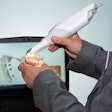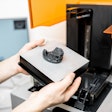Virtual facebow records created with a smartphone 3D scanner may serve as a reliable alternative to conventional facebows, according to a clinical study recently published in the Journal of Prosthetic Dentistry.
Furthermore, a smartphone scanner may provide greater accuracy and cost-effectiveness compared to a conventional facebow, the authors wrote.
"A smartphone scanner could be an accurate and economical approach to making virtual facebow records," wrote the authors, led by Dr. Hasan Al Yousuf of the University of Michigan School of Dentistry (J Prosthet Dent, November 29, 2024).
For this study, facebow records created with a smartphone 3D scanner were compared against the conventional facebow technique. Facebow records were obtained from 10 participants using a virtual facebow record (VFR_SP) with a smartphone 3D scanner and a conventional facebow record (CFR), they wrote.
For the VFR_SP group, a printed facebow fork was used to capture virtual records with a smartphone-based face scanner. For the CFR group, analog facebow records were captured and digitized using an industrial scanner. Cone-beam computed tomography scans with aligned maxillary arch scans served as controls for each participant.
Three reference points were placed on the maxillary arch scans at the right first molar, left central incisor, and left first molar. Linear deviations at the reference points and angular deviations of the occlusal planes were measured using a Python script. Trueness and precision between the two groups were compared using a linear mixed model to account for repeated measures (α = .05), they wrote.
In terms of trueness, the average linear deviations were similar between the two methods. However, VFR_SP exhibited better angular trueness, with an average angular deviation of 1.53° ± 0.80° compared to 2.03° ± 1.66° for CFR, a statistically significant difference (p = 0.046). In terms of precision, VFR_SP demonstrated consistently lower mean linear deviations across all reference points compared to CFR.
When the three reference points were combined, VFR_SP showed significantly lower linear deviation (p < .001). Additionally, VFR_SP exhibited superior angular precision, with an average angular deviation of 1.03° ± 0.71° compared to 2.17° ± 2.11° for CFR, also statistically significant (p < 0.001). While both methods had comparable linear trueness, VFR_SP outperformed CFR in both angular trueness and precision, they wrote.
However, the study had limitations. The study used only one type of conventional facebow and one brand of smartphone with a single 3D-scanning application for virtual facebow records.
Future research should explore the accuracy of virtual facebow records produced by different smartphone-based scanners and various facebow fork designs, the authors added.
"A smartphone 3D scanner may serve as an alternative approach to making facebow records, as the recordings were found to be more accurate and economical compared with those of a conventional facebow," Yousuf and co-authors wrote.




















